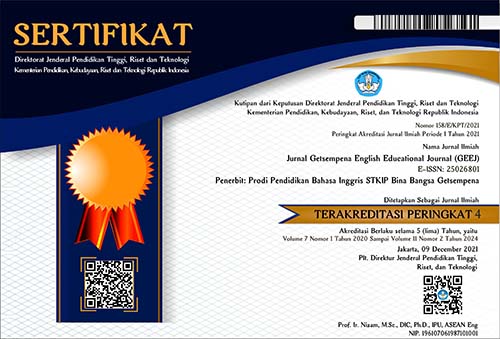THE EFFECTIVENESS OF LITERACY MAPPING ON STUDENTS’ READING NARRATIVE TEXT
Abstract
The objective of this research is to decrease students' reading narrative text and effectiveness their reading level using literacy mapping students' from 8G of SMP Negeri 18 Depok. This study used a Quantitative Method with a Pre-Experimental design by implementing the design of pre-test and post-test. In this study, the writer used one class as the sample with a total of the students' are 30 students'. The data were collected by giving pre-test and post-test as the instrument. The result of the study was calculated using a t-test. The findings showed that the students' post-test scores (were was higher than pre-test scores. By using the t-test, the result of the t-table with degrees of freedom (df) 0.01 obtained 2.048. The findings reveal that these research successes to decrease students' reading narrative text and effectiveness their reading level using literacy mapping.
References
Arikunto, S. (2010). Prosedur Penelitian Suatu Pendekatan Praktik. Jakarta: Rineka Cipta.
Clotheart, M. R. (2001). DRC: A dual route cascaded model of visual word recognition and reading aloud. Psychological review, 204-256.
Cortese, M. J. (2007). Age of acquisition predicts naming and lexicaldecision performance above and beyond 22 other predictor variables: An analysis of 2,342 words. Quarterly Journal of Experimental Psychology. 1072-1082.
Creswell, J. W. (2010). Research Design Pendekatan Kualitatif, Kuantitatif, dan Mixed . Yogyakarta: Pustaka Pelajar.
Edwards, R. and Usher, R. (2000) Globalisation and Pedagogy: space, place and identity. London: Routledge.
Nunan, D. (2003). Practical English language teaching, International Edition. New York.: The McGraw Hill.
Reinking, D. M. (2009). Hand book of literacy and technology. London: Lawrence Erlbaum Assosiated Inc.
Rubiyanto, R. (2009). Metodologi Penelitian Pendidikan. Surakarta: UMS.
Seindenberg, M. S. (1989). A distributed, developmental model of word recognition and naming. Psychological Review, 523-568.
Snow, C. E. (2002). Reading Understanding toward and program in reading comprehension. Pitsburgh: RAND.
Sudjana. (1990). Metode Statistika. Bandung: PT. Gramedia.
Monaghan, P. &. (2010). Modeling reading development: Cumulative, incremental learning in a computational model of word naming. Journal of Memory and Language, 506-525.
Seindenberg, M. S. (1989). A distributed, developmental model of word recognition and naming. Psychological Review, 523-568.
Honig, B. L. (2013). Teaching reading sourcebook, 2nd ed Novato. CA: Arena Press.
Mahmud. (2011). Metode Penelitian Pendidikan. Bandung: Pustaka Setia.
Maulizan, Z. A. (2015). Teaching Reading Comprehension to EFL Junior High School Students. English Education Journal, 370-382.
Merga, M. (2017). What motivates avid readers to maintain a regular reading habit in adulthood? Australian Journal of Language and Literacy, 40(2).
Nasir, Z. I. (2015). Teaching English Based on 2013 Curriculum at Junior High School in Gowa. English Education Dapartment of UIN Alauddin Makkasar, 246-256.
Rauf S. (2012). Improving The Students’ Reading Comprehension By Using Basal. UNISMUH: Makassar.
Ryan, M. R. (n.d.). Self-Determination theory and the facilitation of intrinsic motivation, social development, and well-being. The American Psychological Association, Inc, 55, (1), 68-78 DOI: 10.1037110003-066X.55.1.68.
Sugiyono. (2014). Metode Penelitian Pendidikan Pendekatan Kuantitatif, Kualitatif, dan R&D. Bandung: PT Alfabeta.

























